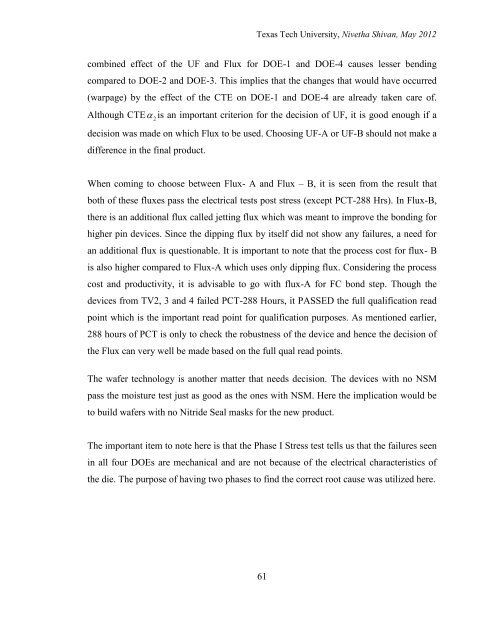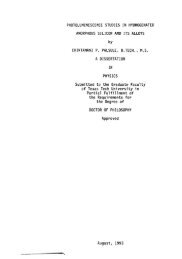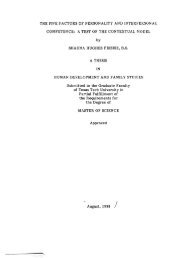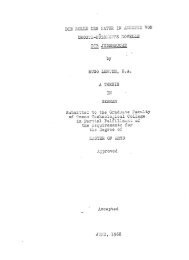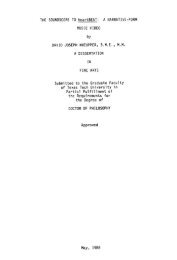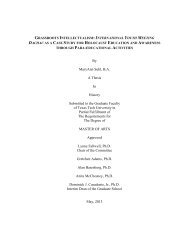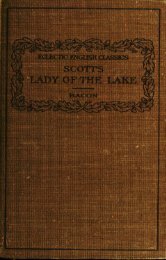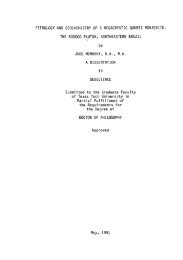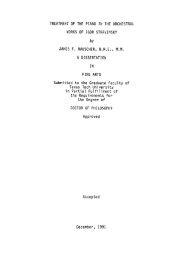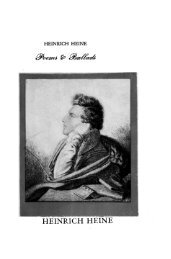Qualification of the Assembly Process of Flip-Chip BGA Packages ...
Qualification of the Assembly Process of Flip-Chip BGA Packages ...
Qualification of the Assembly Process of Flip-Chip BGA Packages ...
Create successful ePaper yourself
Turn your PDF publications into a flip-book with our unique Google optimized e-Paper software.
Texas Tech University, Nivetha Shivan, May 2012<br />
combined effect <strong>of</strong> <strong>the</strong> UF and Flux for DOE-1 and DOE-4 causes lesser bending<br />
compared to DOE-2 and DOE-3. This implies that <strong>the</strong> changes that would have occurred<br />
(warpage) by <strong>the</strong> effect <strong>of</strong> <strong>the</strong> CTE on DOE-1 and DOE-4 are already taken care <strong>of</strong>.<br />
Although CTE� 2 is an important criterion for <strong>the</strong> decision <strong>of</strong> UF, it is good enough if a<br />
decision was made on which Flux to be used. Choosing UF-A or UF-B should not make a<br />
difference in <strong>the</strong> final product.<br />
When coming to choose between Flux- A and Flux – B, it is seen from <strong>the</strong> result that<br />
both <strong>of</strong> <strong>the</strong>se fluxes pass <strong>the</strong> electrical tests post stress (except PCT-288 Hrs). In Flux-B,<br />
<strong>the</strong>re is an additional flux called jetting flux which was meant to improve <strong>the</strong> bonding for<br />
higher pin devices. Since <strong>the</strong> dipping flux by itself did not show any failures, a need for<br />
an additional flux is questionable. It is important to note that <strong>the</strong> process cost for flux- B<br />
is also higher compared to Flux-A which uses only dipping flux. Considering <strong>the</strong> process<br />
cost and productivity, it is advisable to go with flux-A for FC bond step. Though <strong>the</strong><br />
devices from TV2, 3 and 4 failed PCT-288 Hours, it PASSED <strong>the</strong> full qualification read<br />
point which is <strong>the</strong> important read point for qualification purposes. As mentioned earlier,<br />
288 hours <strong>of</strong> PCT is only to check <strong>the</strong> robustness <strong>of</strong> <strong>the</strong> device and hence <strong>the</strong> decision <strong>of</strong><br />
<strong>the</strong> Flux can very well be made based on <strong>the</strong> full qual read points.<br />
The wafer technology is ano<strong>the</strong>r matter that needs decision. The devices with no NSM<br />
pass <strong>the</strong> moisture test just as good as <strong>the</strong> ones with NSM. Here <strong>the</strong> implication would be<br />
to build wafers with no Nitride Seal masks for <strong>the</strong> new product.<br />
The important item to note here is that <strong>the</strong> Phase I Stress test tells us that <strong>the</strong> failures seen<br />
in all four DOEs are mechanical and are not because <strong>of</strong> <strong>the</strong> electrical characteristics <strong>of</strong><br />
<strong>the</strong> die. The purpose <strong>of</strong> having two phases to find <strong>the</strong> correct root cause was utilized here.<br />
61


